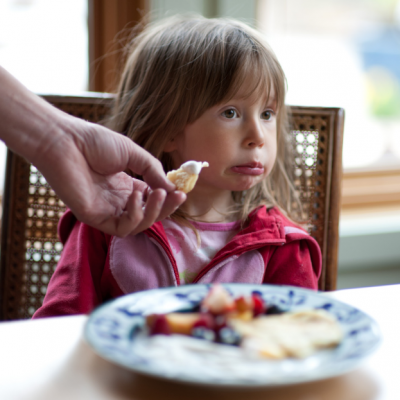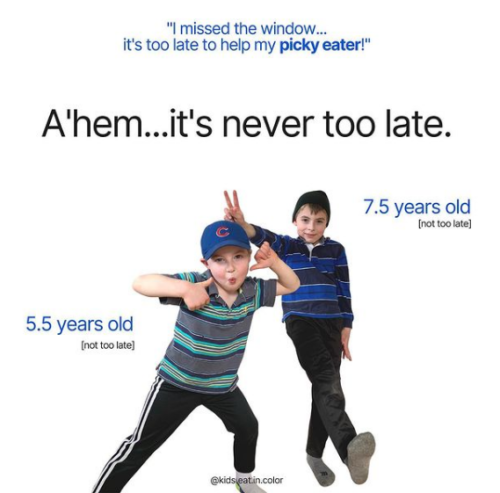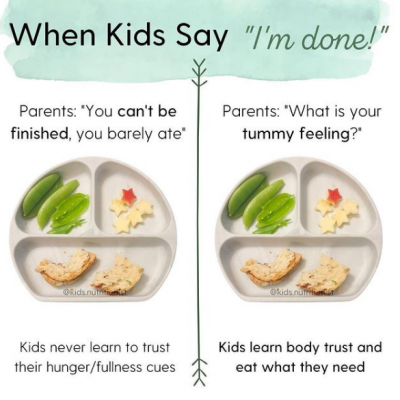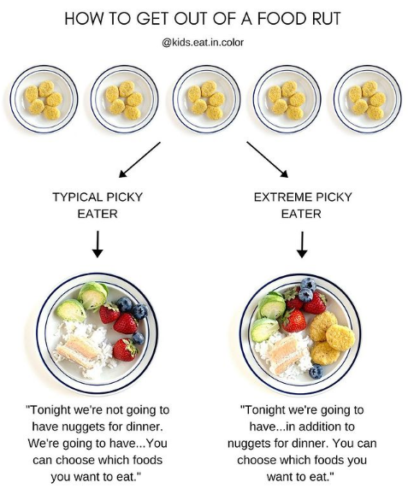Home | Picky Eating: Baby Steps
If you’d like, take a moment to do a thought experiment with me. Imagine that you’ve traveled to a foreign country and have just sat down to enjoy some of the local authentic cuisine. You don’t know what to expect, really…you’ve never eaten this kind of food before. What if it tastes weird? What if you don’t like it? What if it’s from an animal you wouldn’t normally eat? What if it makes you sick? What if…? Your plate arrives, and sure enough – it’s totally unfamiliar, gives you the weird willies, and you’re not sure you want to eat it after all.
Sometimes that’s what it’s like for a kid when they encounter a new food. Only they don’t have the comforting backstop of previous lived experience to reassure them that new things can be delicious, nutritious, exciting, memorable – all they know is “I DON’T LIKE IT (yet).”

Learning how to eat takes time!
Kids are always learning. Always! Emotional regulation, motor skills, decision making, and body awareness are all skills that adults may take for granted, but children are sort of improvising as they go. These skills are all related to eating as well. Remember when we talked about how to tune in to your body’s signals about hunger, satiety, and thirst? Childhood is a critical period of learning and growth around how to recognize and respond to these signals in a healthy way! Three of the biggest ways that kids learn are through observation, playing, and repeated exposures.
As a parent or caregiver, you may feel pressure to make sure a child is eating enough, eating the “right” foods, meeting their growth standards, and so on. To complicate things further, children’s eating behaviors change depending on their age or stage of development, which can leave the adults who care for them scrambling to adapt. It can be frustrating for adults to navigate, but perhaps it can comfort you to know that it’s frustrating for the kid, too, albeit for different reasons.

Got the mealtime blues?
I’d like to reassure you that “picky eating” is not the formidable enemy it has been made out to be. Hard and maddening? Possibly. Inherently bad and foreboding? No. For a kid, “picky eating” is really just their way of learning how to safely and autonomously interact with food. It’s natural. It’s normal. And you haven’t failed your child or failed as a parent if you’re struggling with a selective, assertive, irregular eater. We’ll talk more about why picky eating happens, how childhood development influences food preferences and feeding behaviors, and how you can hack these realities to help your kid learn to eat well and bring some peace back into your family’s mealtimes.
Baby steps can take you and your little one far when it comes to limited food interests. Here’s one that’s a great place to start, although it might surprise you…

Understand your respective roles
It can help to understand where to draw the line between your role and your child’s role when it comes to helping them learn how to eat. Ready?
1) You are in charge of what is served and when.
- You set the menu and provide flexible structures and guidance.
- You may incorporate requests or suggestions and adapt based on your child’s needs, but until they’re old enough, this ball is in your court.
- This keeps you from becoming a short-order cook and helps them learn balance.
2) Your child is in charge of their body.
- They get to decide how much to eat, when they are done eating, or if they are going to eat at all.
- This helps them learn autonomy and body intuition, skills they will need one day when a parent/caregiver isn’t providing their food anymore.

This might sound crazy at first, but hear me out. As much as we may wish we could, we can’t make a child eat on command, even though we have their best interests at heart. When we pressure kids about eating, whether subtly or overtly, it usually backfires. In the short-term it makes them more resistant or obsessive about certain foods while making you feel more desperate. Removing the pressure makes trying new foods less overwhelming and let’s them try it when they’re ready. Pro tip: it can take multiple low-pressure attempts before a child feels comfortable trying something new…more on that to come!
Ready to try it out? There’s a small but mighty way to ease into this mindset and put a stop to mealtime battles. The magic phrase is… “You don’t have to eat it.” Did I really just say that?! Yep. “You don’t have to eat it. I hear you asking for macaroni instead, but macaroni isn’t on the menu right now. We can have macaroni with dinner tomorrow. I know it’s hard to wait.”

A gentle reminder
Every family is different. Every child is different. Heck, every new day can feel like a roll of the dice. If something doesn’t work at first, that’s okay. You can try again later or try something different. Give yourself and your little one grace as you make this journey together one step at a time, however bumpy it may feel some days. You’re doing an awesome job!
